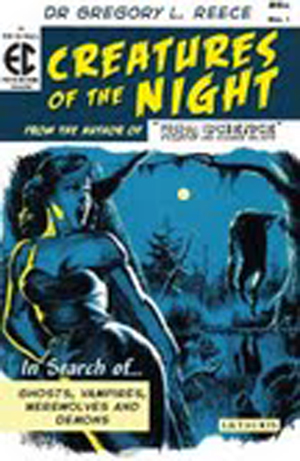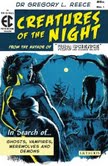 Thanks to Religionnerd.com for sharing.
Thanks to Religionnerd.com for sharing.
By Gregory L. Reece, PhD
The sound began down deep in his chest, rose to a growl in his throat, and then forced its way between his lips as a snarl. The coarse silver hair on his neck bristled. His ears, covered with the same silver fur, twitched. There was a burst of air from his nostrils, a snort of warning and territorial claim. The muscles in his arm began to twitch. His head snapped quickly to the left, then to the right. Thrown back against my seat by a sudden change in direction and speed, I instinctively clutched at the door handle of the mini-van, my eyes darting between the oncoming traffic and the hairy form in the driver’s seat. His reactions to the traffic were quick and aggressive – canine reactions, lupine reactions. For just a moment I was terrorized, speeding down the highway with a werewolf at the wheel.
***
I had lunch with Wolf at a local “meat and three” restaurant. Unlike Warren Zevon’s London werewolf, we didn’t have beef chow mein or pina coladas (and Wolf’s unruly fur was far from “perfect”), but instead ordered meat loaf, tomato pie, and iced tea. Throughout the meal Wolf was uncomfortable in his straight-backed chair which offered no place for his (invisible) tail. Other than that he seemed completely at ease in his own skin, more than happy to talk to me about his wolf-nature and the werewolf community of which he is a part.
Werewolves, Wolf explained, are by their nature mostly solitary creatures, joining packs only occasionally for woodland gatherings known as Howls. Wolf is one of the elder weres in an annual gathering known as the Southeastern or SEHowl, billed as one of the largest and longest running Howls in the country. Mostly, however, the werewolf community is found online, in chatrooms like The Werewolf Café (werewolfcafe.com) and The Werelist (werelist.net). Online, Wolf often plays the role of an expert, or at least as someone who has been around for a while, knows a lot of other werepeople, and is not afraid to state his mind and share his personal experiences.
Wolf traces the origins of modern werewolves to the late twentieth century, when some people began realizing, as children, that there was something different about them. They lived life more intentionally, paid more attention to what was going on around them, were more empathic, and felt as though they did not quite fit in with the people around them. On the other hand, they identified very well with various nonhuman animals – often to the point of conceptualizing themselves as nonhuman. (thetheriantimeline.com)
These individuals should not be thought of dysfunctional misfits, however. According to wolf
On the average, they got along well with their families, they had friends, they succeeded in school, many worked for themselves, many worked for others, and they were happy and well adjusted. But they were unique, as far as they knew, and they kept their differences a secret.
Then, in the early 1990’s, with the birth of the internet, this diverse group of individuals began to find each other. An online group, alt.horror.werewolves, founded as a forum for fans of werewolf movies soon became a forum for the discussion of members’ personal lives and experiences. As Wolf puts it, “The Weres had found each other.”
***
Though always careful to emphasize that his theories are his alone and that he does not speak for the therian community as a whole, Wolf does not hesitate in sharing his own personal understanding of the modern werewolf phenomenon. He believes, for example, that present-day therians are genetically linked to the European werewolf community of the middle ages and that population and environmental pressures may have resulted in the reawakening of this long-hidden hereditary strain.
Wolf writes,
Before the Werewolf Trials of the later Middle Ages when thousands of mentally ill or simply despised people were tortured to death by the Inquisition for being “werewolves”, there really were people known as “werewolves”. Far from being insane, they were respected in their communities. They even had a special position in the church – they were called the Dogs of God and Saint Peter’s Wolves.
Wolf finds evidence for the existence of these holy werewolves in some of the ancient legends themselves, but especially in the records of the Inquisition regarding the trial in 1692 of the Livonian werewolf Thiess as recorded by Carlo Ginzburg in his The Night Battles: Witchcraft and Agrarian Cults in the Sixteenth and Seventeenth Centuries (1983).
According to Ginzburg, the elder Thiess confessed freely to the charge of being a werewolf. He also claimed that he once suffered a broken nose during a battle with a peasant named Skeistan, who happened to have been deceased at the time. Skeistan was a witch and had risen from his grave along with other witches to carry seed grain into hell in order to curse the community’s crops. Thiess, as a werewolf, had battled to stop this travesty, and had been hit in the face with a broomstick by the witch. Thiess also claimed that such battles took place three times each year, on the night of St. Lucia before Christmas, at Pentecost, and on the night of St. John. On these nights, the werewolves proceeded on foot, in the form of wolves, to a place ‘beyond the sea’: hell. There they battled the devil and witches, striking them with long iron rods, and pursuing them like dogs. Werewolves, Thiess exclaimed, ‘cannot tolerate the devil.’ (29)
When the judges demanded to know why Thiess and the others would transform themselves into dogs and journey to hell, he explained that they went in order to bring back from hell those things that had been taken there by the witches, livestock, grain and other agriculture fruits. To fail in their task would mean a lean year for the harvest and hunger for the people.
The judges in this account seemed quite shaken by this strange testimony. They apparently had great difficulty in understanding werewolves as being on the side of God and opposed to the devil. Thiess kept insisting however, that werewolves were anything but the servants of the devil. The devil was their enemy to the point that they, just like dogs – because werewolves were indeed the hounds of God – pursued him, tracked him down, and scourged him with whips of iron. They did all of this for the sake of mankind: without their good work the devil would carry off the fruits of the earth and everyone would be deprived as consequence. (29)
Ginzburg argues that judges’ understanding of werewolves as servants of the devil notorious for destroying livestock was incompatible with what seems to be an older concept of werewolves as servants of God. Thiess, he argues, represents an older understanding of werewolves in which the dogs of God battle witches and devils in defense of a bountiful harvest. In addition to the evidence of Thiess’s advanced age, and the assumption that he acquired his beliefs about werewolves at an early age, Ginzburg also notes a mid-sixteenth century tale of a young man of Riga who fell to the ground during a banquet. One of the witnesses recognized the man as a werewolf. When he revived the young man related that he had left his body to battle a witch that had been flying around in the shape of a red-hot butterfly.
This was an ancient belief, then. But . . . under pressure from the judges, the original positive qualities of the werewolves began gradually to fade away and become corrupted into the execrable image of the man-wolf, ravager of the livestock. (31-32)
Wolf VanZandt believes that the ancient dogs of God, the hounds of St. Peter, are once again on the move, called for what purpose he is not yet sure. Modern therians may be the new hounds of God, when their struggling consciousness finally comes to shake off the false histories that they have been taught. Hundreds of years of false consciousness must fade away for the werewolf to once again hear the call to battle with the forces of evil. All the horrible tales of old were told from confused or sinister motives, but the truth remains, hidden even in the ancient legends and tales. The wholly other within the werewolf breast is the presence of the divine.
**********************
About the author: Gregory L. Reece, Ph.D
Greg holds a Ph.D in Religious Studies from the Claremont Graduate University with a specialty in philosophy of  religion and theology, an M.Div. from the Vanderbilt University Divinity School, a B.A. from Samford University, and an A.A. from Martin Methodist College.
religion and theology, an M.Div. from the Vanderbilt University Divinity School, a B.A. from Samford University, and an A.A. from Martin Methodist College.
His studies in philosophy of religion, particularly his work on irony and religious belief, have led Greg to explore religion from its more idiosyncratic border regions rather than from its more stable centre. In pursuit of an understanding of religion, he has attended an Elvis Impersonator contest in Las Vegas, celebrated the birth of the King of Rock and Roll in Memphis, attended UFO and Tesla Technology conventions, had his molecules rejuvenated via the alien technology of the Integratron, visited Roswell and Area 51, had a close encounter with the extraterrestrials known as the Tall Whites, explored an underground cavern rumored to lead to a subterranean civilization, hunted Bigfoot outside of Paris, Texas, attended a Satanic mass, interviewed vampires, been trained in the art of exorcism, and gone hiking with a werewolf.
Greg’s fancy degrees and weird adventures, while incredibly interesting, have not provided him with steady employment. For that he works as a technical writer and consultant, providing human resources support to municipal governments and colleges. He occasionally teaches courses in philosophy and religion at Birmingham, Alabama colleges.
Greg lives at Brookehouse, a big, old home in the Montevallo, Alabama historic district, along with his wife Kristen, his son Sam, and his daughter Olivia. In his spare time, and when he is not making plumbing repairs, he likes to build robot, spaceship, and ray-gun sculptures from junk he finds at the thrift store.
Shared from Religionnerd.com
The Dogs of God,




Rachel
18 Mar 2012One features in Neil Gaiman’s The Graveyard Book. That said, Otherkin are a srange bunch.
Cindy
18 Mar 2012During the Middle Ages, many of the poor ate rye bread because it was cheap. Some ingredient in rye will make you hgh if u consume enough of it. Combine that fact with this disease that causes one to be covered with hair all over the body and with the mental disease called lycanthorpy in which one desplays the ways of a wolf, and the myth of the human turning into, becoming a wolf, was born.
Oscar
18 Mar 2012Its on days like this I really love the internet! Thanks for (even more) new things to follow up and study.